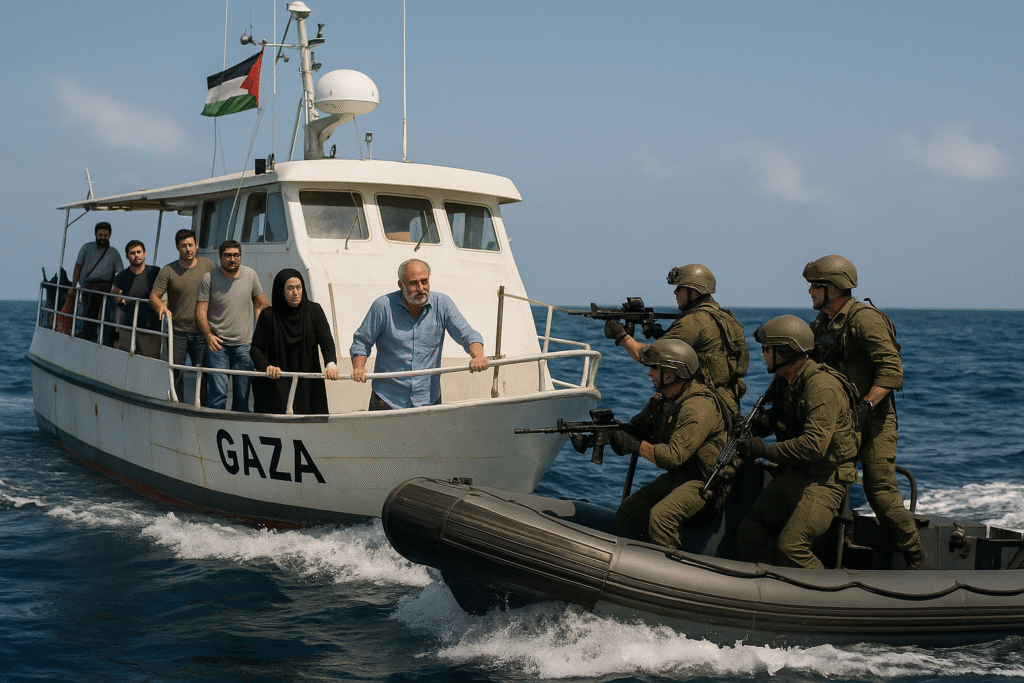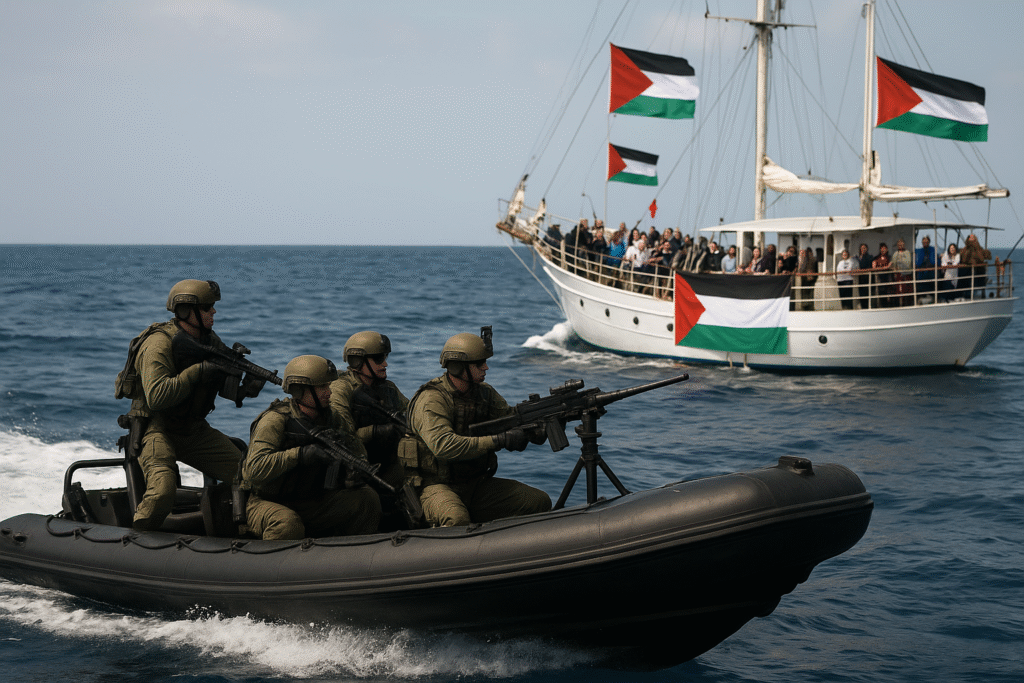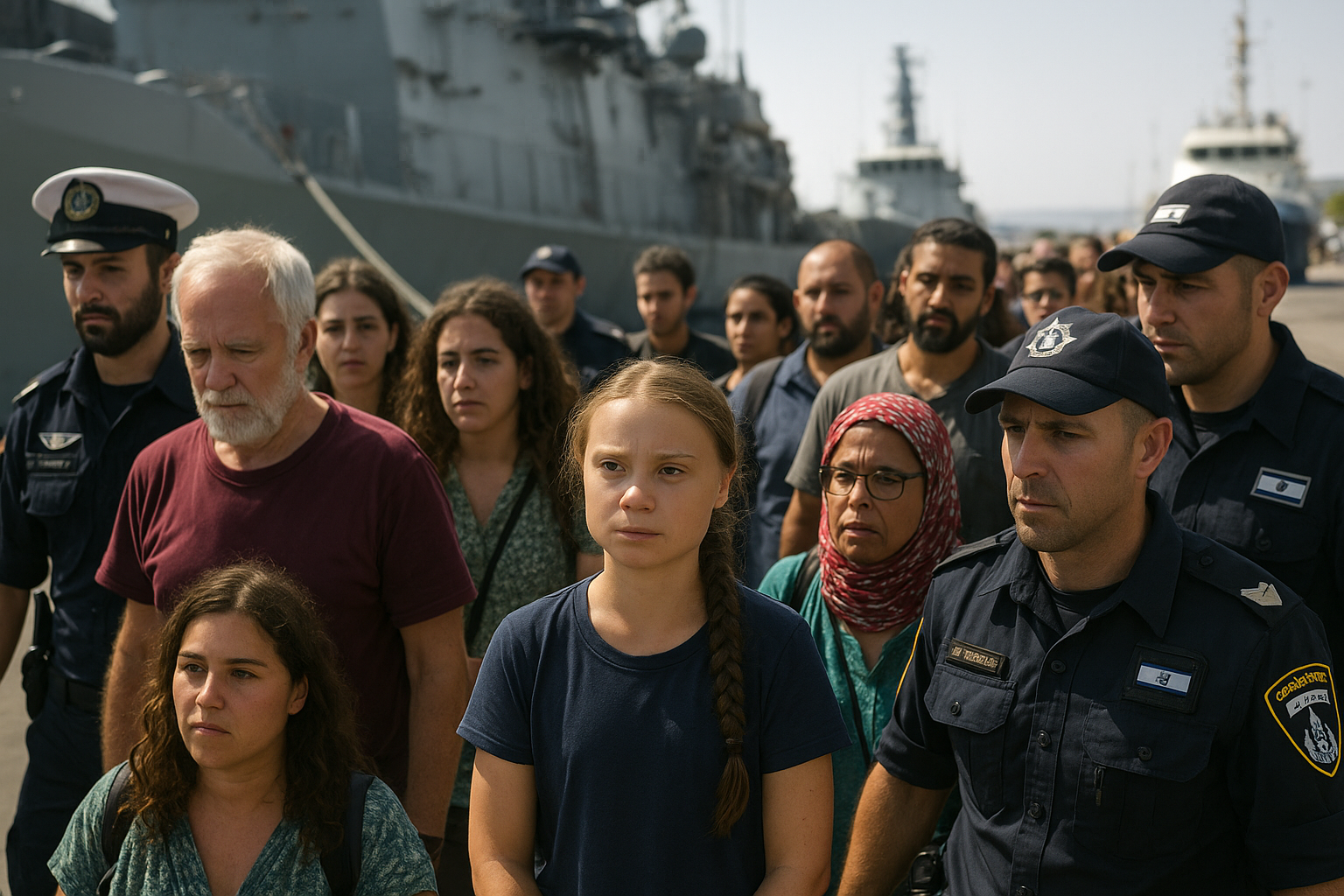Quick summary — Gaza bound Flotilla Interception
- On 1–2 October 2025, the Israeli navy intercepted much of the Global Sumud Flotilla, a convoy of dozens of civilian boats attempting to reach Gaza with humanitarian supplies and protest the maritime blockade. Dozens of activists and several high-profile passengers — including Swedish climate activist Greta Thunberg — were taken into Israeli custody and transported to an Israeli port, where authorities said they would be processed for deportation.
- Organisers say the convoy included around 40 vessels and 400–500 activists; Israel says it stopped the majority of the boats and characterised the mission as a security provocation. Video and photos released by Israel’s foreign ministry showed detained activists, including Thunberg.
- The interception triggered widespread diplomatic protests, solidarity demonstrations and statements of condemnation from human-rights groups that described the seizure as unlawful. Governments and NGOs differ sharply on legality and the humanitarian stakes.
1) What exactly happened — the verified facts
The Global Sumud Flotilla set out from multiple Mediterranean ports carrying symbolic humanitarian aid and hundreds of international activists and observers. As the convoy approached Gaza-adjacent waters, Israeli naval vessels boarded and diverted many of the flotilla boats; Israeli authorities said activists were “safe and healthy” and were being taken to Ashdod for processing and deportation. Activists and organisers said their boats had been boarded, some were subject to aggressive tactics (water cannon, stun devices, ramming claims), and that many people were detained in international waters.
(These are the core, cross-checked assertions from major wire services and eyewitness footage.)
2) Who was on board — notable passengers and organisers
The Global Sumud Flotilla included an international mix: parliamentarians, lawyers, journalists, humanitarian volunteers and prominent campaigners. Among those publicly reported as detained or removed to Ashdod were Swedish activist Greta Thunberg, former Barcelona mayor Ada Colau and a number of European lawmakers and civil society figures. Organisers described the mission as peaceful and humanitarian; Israeli officials called it a political provocation and said the blockade must be enforced for security reasons.
3) Numbers, geography and logistics — how big was this convoy?
Organisers and media reports put the convoy at roughly 40–45 vessels and 400–500 participants, making it one of the largest maritime attempts to challenge the Gaza blockade since the 2010 Mavi Marmara incident. Israeli authorities reported boarding and diverting many of the boats and transferring activists to Israeli ports. Some reporting also indicated that at least one smaller vessel may have slipped through or reached Gaza territorial waters — accounts are still being verified.

4) Israel’s official position — security and deportation
Israel’s foreign ministry and defence authorities framed the flotilla as an attempt to enter a “combat zone” and a possible threat to security; they published footage showing detained activists and said they would be deported after processing. Israel also said it offered to deliver humanitarian goods through established, inspected channels rather than via a politically charged maritime corridor. Those statements are the basis for its legal justification; critics say intercepting vessels in international waters raises legal and humanitarian questions.
5) The flotilla’s claim — humanitarian corridor and protest
Organisers described the Global Sumud Flotilla as a civil-society effort to open a maritime humanitarian corridor to Gaza and to spotlight what they call a humanitarian crisis. Activists argue that if conventional aid channels are blocked or insufficient, direct civil action is sometimes necessary to draw attention and deliver relief — a claim contested by Israel, which warns such actions could be exploited by militant groups.
6) International reaction — protests, diplomacy, and legal questions
The interception sparked fast global reaction:
- Diplomatic notes and demands: Several governments expressed concern or summoned Israeli envoys to seek explanations for detained nationals; some called for urgently released detainees. Ireland, Spain and South Africa were among countries issuing prompt statements.
- Solidarity protests: Demonstrations occurred in multiple cities (Rome, Istanbul, Buenos Aires, etc.) within hours of the interception.
- Human-rights organisations: Groups such as Amnesty International condemned the interception, calling it unlawful and arguing it intensified a pattern of restricting humanitarian access to Gaza. Legal commentators referenced the 2010 Mavi Marmara precedent and stressed that whether the blockade can be lawfully enforced depends on maritime law, the exact location of the boarding and the proportionality of force used.
7) Legal and practical implications — what happens to the detained activists?
When activists are taken to an Israeli port, standard procedures typically include identification checks, medical checks and deportation hearings. Under international maritime law there are contested rules about boarding vessels in international waters if a blockade is lawfully declared and enforced, but the legality of Israel’s blockade and its application in this conflict are hotly disputed. Several countries and legal experts have said the interception will likely be examined under multiple legal lenses — from search and seizure in international waters to humanitarian-law obligations during wartime. Expect diplomatic follow-ups and, potentially, legal challenges by activist groups or states whose nationals were detained.

8) Humanitarian context — why activists say this mission matters
Gaza remains under tight maritime and land restrictions that humanitarian agencies and UN bodies have repeatedly said hamper the flow of adequate, timely aid. Organisers argue that their mission sought to deliver life-saving supplies and to force the international community into action about blockade policies. Critics respond that unregulated maritime deliveries risk diversion to armed groups and that aid should be coordinated through established humanitarian channels — a debate that rarely resolves in the moment of interception.
9) How the media and social feeds are shaping the story — caution for readers
Live video from flotilla vessels and social channels circulated quickly, and both Israeli authorities and organisers published material to make competing claims (Israel: detainees are safe and will be deported; activists: they were abducted or subjected to aggressive actions). When following this story:
- Prefer verified wire agencies and direct official statements over unverified clips.
- Be cautious about emotionally charged or out-of-context footage — these events often produce misleading short clips that circulate widely before verification.
10) What to watch next — short- and medium-term developments
- Deportation and consular access: Countries with nationals aboard will press for consular access and the swift return of their citizens. Watch foreign ministry statements for status updates.
- Legal challenges and UN/ICJ attention: Human-rights NGOs and some national governments may escalate legal complaints or seek international investigations into whether international law or humanitarian norms were breached.
- Further flotilla actions or political fallout: Organisers may regroup and attempt other routes; the interception is likely to be a renewed catalyst for global protests and parliamentary questions in many countries.
FAQs — quick answers readers want
Q: Is Greta Thunberg under arrest?
A: Major outlets reported that Greta Thunberg was among those detained and taken to an Israeli port; Israeli officials said she was “safe and healthy” and would be processed for deportation. Organisers and activists characterised the seizure as forcible.
Q: Was the flotilla trying to deliver a lot of food or heavy aid?
A: Organisers described the cargo as symbolic humanitarian supplies; large shipments of food into Gaza generally require inspected delivery through recognised cross-border channels. The flotilla’s legal and practical ability to deliver large quantities without inspection is contested.
Q: Is boarding ships in international waters legal?
A: International law permits blockades in armed conflict in limited circumstances, and a blockading state may take measures to enforce a blockade — but whether Israel’s blockade and the interception meet legal tests is disputed and often litigated. Legal outcomes depend on details such as location, proportionality, and whether adequate alternatives for humanitarian access exist.
Responsible reading and sharing — a final word
This is a fast-moving event with strong political and emotional stakes. TrenBuzz will update this page as official statements, consular notices and verified legal analyses are released. For now:
- Rely on reputable wire services and official government statements for updates.
- Do not amplify unverified videos that might endanger people or misrepresent events.
Verified sources & useful links
Below are the authoritative reports and official statements used to compile this article. Each link was active at the time this article was published.
- Reuters — Gaza aid flotilla with Greta Thunberg intercepted by Israeli navy (live/analysis). https://www.reuters.com/world/europe/israel-stops-13-gaza-aid-boats-organisers-say-sparking-international-criticism-2025-10-02/ (Reuters)
- The Associated Press (AP) — Israeli navy intercepts boats attempting to break Gaza blockade and arrests activists. https://apnews.com/article/efc168795ecaea6d569bcb3eba4254c5 (AP News)
- Al Jazeera — Israel intercepts Gaza Sumud flotilla vessels: What we know so far. https://www.aljazeera.com/news/2025/10/1/israel-intercepts-gaza-sumud-flotilla-vessels-what-we-know-so-far (Al Jazeera)
Disclaimer: This TrenBuzz article summarises verified reporting from major international news agencies, human-rights organisations and official statements available as of October 2, 2025. Events are ongoing and details may change; always consult the primary sources above (official foreign ministries, Reuters/AP/Al Jazeera) for the latest updates before acting on or sharing breaking material. Images used in this article are royalty‑free or licensed for commercial use and are provided here for illustrative purposes.
